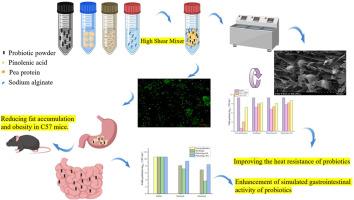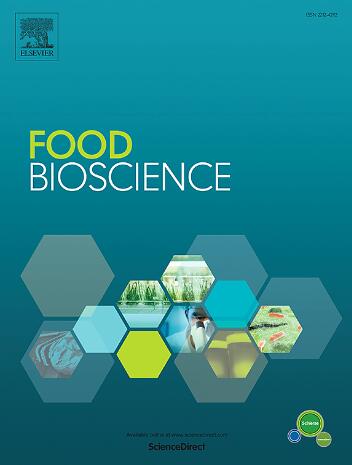不同浓度海藻酸钠稳定植物乳杆菌H6皮克林乳剂的制备
IF 5.9
1区 农林科学
Q1 FOOD SCIENCE & TECHNOLOGY
引用次数: 0
摘要
本研究旨在提高植物乳杆菌H6(L)的胃肠道存活率。以皮克林乳剂为基础,研制了一种防护包封体系。随后在高脂肪饮食(HFD)喂养的小鼠中评估了该系统减轻肥胖的功效。以豌豆分离蛋白(PP)和海藻酸钠(SA)为水相配制酸洗乳。加入葡萄糖- δ内酯(GDL)、碳酸钙(CaCO3)和蒎烯酸(PLA),高速分散制得最终乳状液。结果表明,含有SA的乳剂的包封效率高达91% (p < 0.05),突出了其优越的益生菌保护能力。所有乳剂的zeta电位绝对值均超过40 mV,具有良好的胶体稳定性。激光共聚焦显微镜显示,随着SA浓度的增加,油滴尺寸减小,这是由于均匀化过程中水相粘度的增强产生了更强的剪切力。低温电子显微镜(Cryo-EM)进一步显示,含sa的乳剂形成了三维凝胶网络,这种空间结构为被封装的益生菌提供了增强的保护。动物实验表明,与高脂肪饮食(HFD)对照组相比,皮克林乳剂的施用显著降低了6.8%的体重增加。此外,乳剂治疗改善了肥胖小鼠的炎症标志物和脂质谱,减轻了脂肪肝疾病。Pickering组有效降低了血清总胆固醇TC(33.3%)、甘油三酯TG(3.5%)和低密度脂蛋白LDL-C(50%)水平(p < 0.01),同时提高了高密度脂蛋白HDL-C(50%)水平。本研究强调了Picklin乳剂在益生菌输送中的潜力,并探讨了不饱和脂肪酸(PLA)和益生菌的综合效益。基于动物模型实验结果和体内观察到的协同效应,未来的研究应侧重于将pla -益生菌的协同效应转化为多组学指导的功能食品,以实现个性化的抗肥胖干预。本文章由计算机程序翻译,如有差异,请以英文原文为准。

Preparation of pinolenic acid-embedded Lactiplantibacillus plantarum H6 Pickering emulsions stabilized with different concentrations of sodium alginate
This study aimed to enhance the gastrointestinal survival of the probiotic Lactiplantibacillus plantarum H6(L.p H6)by developing a protective encapsulation system based on Pickering emulsions. The efficacy of this system in alleviating obesity was subsequently evaluated in high-fat diet (HFD)-fed mice. Pickering emulsions were formulated using pea protein isolate (PP) and sodium alginate (SA) as the aqueous phase. Glucono-delta-lactone (GDL), calcium carbonate (CaCO3), and pinolenic acid (PLA) were incorporated, followed by high-speed dispersion to produce the final emulsions. Results demonstrated that emulsions containing SA achieved an encapsulation efficiency of up to 91 %(p < 0.05), highlighting their superior capacity for probiotic protection. The absolute zeta potential values of all emulsions exceeded 40 mV, indicating excellent colloidal stability. Laser confocal microscopy revealed a reduction in oil droplet size with increasing SA concentration, attributed to the enhanced aqueous phase viscosity generating stronger shear forces during homogenization. Cryo-electron microscopy (Cryo-EM) further showed that SA-containing emulsions formed a three-dimensional gel network, a spatial configuration offering enhanced protection for the encapsulated probiotics. Animal experiments demonstrated that administration of the Pickering emulsion significantly reduced body weight gain by 6.8 % compared to the high-fat diet (HFD) control group. Furthermore, the emulsion treatment improved inflammatory markers and lipid profiles in obese mice and alleviated fatty liver disease. The Pickering group effectively reduced total serum cholesterol TC (33.3 %), triglyceride TG (3.5 %), and low-density lipoprotein LDL-C (50 %) levels(p < 0.01),while increasing high-density lipoprotein HDL-C (50 %) levels. This study highlights the potential of Picklin emulsion in probiotic delivery and explores the combined benefits of unsaturated fatty acids (PLA) and probiotics. Based on the results of animal model experiments and the synergistic effects observed in vivo, future research should focus on translating the PLA-probiotic synergistic effect into multi-omics-guided functional foods to achieve personalised anti-obesity interventions.
求助全文
通过发布文献求助,成功后即可免费获取论文全文。
去求助
来源期刊

Food Bioscience
Biochemistry, Genetics and Molecular Biology-Biochemistry
CiteScore
6.40
自引率
5.80%
发文量
671
审稿时长
27 days
期刊介绍:
Food Bioscience is a peer-reviewed journal that aims to provide a forum for recent developments in the field of bio-related food research. The journal focuses on both fundamental and applied research worldwide, with special attention to ethnic and cultural aspects of food bioresearch.
 求助内容:
求助内容: 应助结果提醒方式:
应助结果提醒方式:


